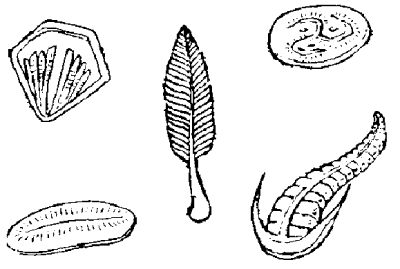 |
Science Frontiers ONLINE No. 33: May-Jun 1984 |
|
|
The failure of two-dimensional life
The fossil record tells us that just prior to the Cambrian explosion of life, the earth was populated by a diverse assemblage of soft-bodied, shallow-water marine invertebrates, some with dimensions as large as 1 meter. This whole group of animals did not survive into Cambrian times, thus ending what has been termed The Ediacaran Experiment. Some paleontologists have tried to find similarities between the Ediacaran and Cambrian life forms to preserve the continuity of life. This has proved difficult, and some scientists now feel that The Edicaran approach to "largeness" was to increase surface area externally. The Ediacarans were therefore shaped like pancakes, tapes, fans, etc. This enabled them to present large areas to the environment for respiration, feeding, and other biological functions.
In contrast, many present life forms achieve "largeness" by increasing internal areas, as in the lungs, folded intestines, etc., along with the forced circulation of air, blood, and other sub stances. This latter approach survived, while the two-dimensional Ediacaran Experiment did not. The demise or extintcion of the Ediacarans led Gould, the author of this far-ranging article, to the influence of extinctions on life in general -- a hot topic these days. Gould stated that with natural selection operating, one would expect continual "improvement" in life forms, but that this had not happened.
"I regard the failure to find a clear 'vector of progress' in life's history as the most puzzling fact of the fossil record. But I also believe that we are now on the verge of a solution, thanks to a better understanding of evolution in both normal and catastrophic times. We need a twotiered explanation for patterns (or non-patterns) in the history of life."
The first tier of explanation involves the theory of punctuated equilibrium, as championed by Gould and Eldredge. Gould says he once thought that punctuated evolution would be sufficient to explain all of life's development, but that now a second tier seemed required; namely, a general theory of mass extinction or what catastrophism does to life and its development.
(Gould, Stephen Jay; "The Ediacaran Experiment," Natural History, 93:14, February 1984.)
 | Ediacaran life forms were typically flattish to maximize external area. |